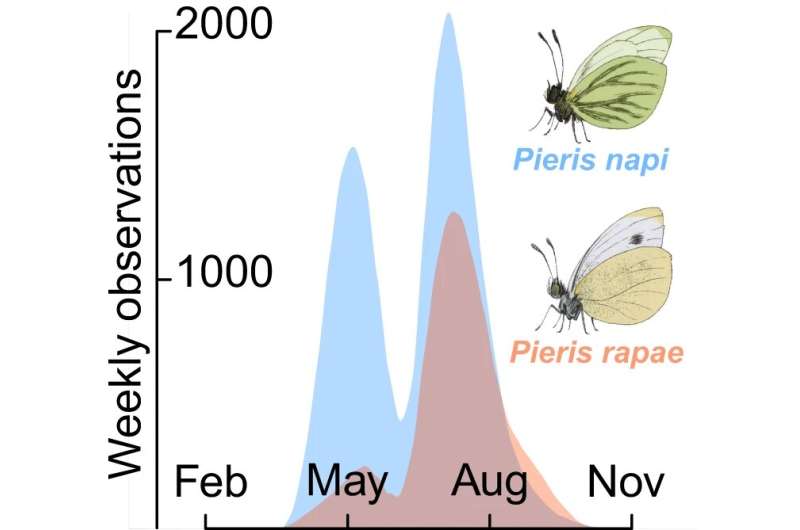This article has been reviewed according to Science X's editorial process and policies. Editors have highlighted the following attributes while ensuring the content's credibility:
fact-checked
peer-reviewed publication
trusted source
proofread
Seasonal specialization in butterflies determines responses to a changing climate

Summer and winter seasons constitute vastly different living conditions for animals and plants in many parts of the world. So how have different organisms evolved to cope with this variation? A study by researchers at Stockholm University published in Nature Communications investigates this question by studying two closely related butterfly species, the small white butterfly and the green-veined white butterfly.
"Our approach to looking at seasonal adaptations can help us understand how species will respond to changing conditions in the future," says Loke von Schmalensee, a doctoral student in ecology at the Department of Zoology at Stockholm University.
"Superficially, the butterflies are alike. Both are medium-sized and white, and under common conditions, they generally prefer to lay eggs on the same type of cruciferous plants. They co-occur in much of Sweden, and where they do, their two annual generations coincide in time," says Loke von Schmalensee.
In other words, the small white butterfly and the green-veined white butterfly are ecologically very similar. Despite this, by analyzing observations of butterflies reported by citizen scientists at www.artportalen.se, the research team discovered that the two species differ drastically in how their two annual generations differ in size. The small white butterfly's first annual generation during spring and early summer (consisting of newly hatched butterflies that have overwintered as pupae) is much smaller in number than the second, late-summer, generation. The green-veined white butterfly, on the other hand, has two relatively even-sized generations.
"The small white butterfly is better than the green-veined white butterfly at reproducing over the summer but has poorer winter survival. It appears to be a 'summer specialist' and the green-veined white butterfly a 'winter specialist.' This is reflected in a range of temperature adaptations," says Loke von Schmalensee.
For example, the small white butterfly prefers to lay eggs in warmer places during the summer than does the green-veined white butterfly, and this preference difference corresponds to differences in physiological temperature adaptations.
"In lab experiments, we show that the heat-loving small white butterfly both grows and develops faster under warm conditions than the green-veined white butterfly, also with higher survival chances under extreme heat. In turn, the green-veined white butterfly copes better with cold overwintering conditions. When individuals experience contrasting seasons throughout their lives, it seems that there are several evolutionary solutions to the seasonal challenges. Maximizing gains during the summer season, perhaps at the expense of winter survival, is a viable strategy—investing in winter adaptations is another," says Loke von Schmalensee.
The heat-adapted "summer specialist," the small white butterfly, has performed better over the past decade than the "winter specialist," the green-veined white butterfly. On the other hand, the small white butterfly appears incapable of spreading as far north as the green-veined white butterfly, as the summer season then becomes too short to produce two generations. Without a second generation for the small white butterfly populations to recover from the winter losses, they collapse.
"Because of this, northern latitudes or high mountains might constitute important refugia for 'winter specialists' in a warming world. This is an example of how our results can help us predict organisms' responses to a changing climate," says Loke von Schmalensee.
More information: Loke von Schmalensee et al, Seasonal specialization drives divergent population dynamics in two closely related butterflies, Nature Communications (2023). DOI: 10.1038/s41467-023-39359-8
Journal information: Nature Communications
Provided by Stockholm University

















